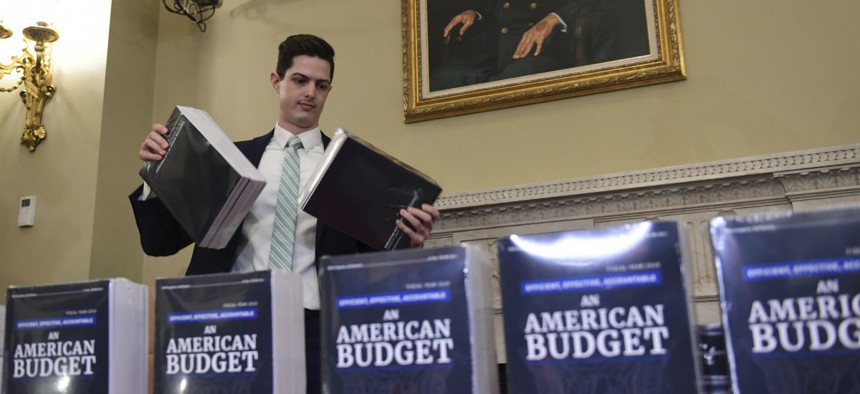
James Knable helps to unpack copies of President Trump's FY19 Budget after it arrived at the House Budget Committee office on Feb. 12. Susan Walsh/AP
New Details on Trump's Performance Pay Plan
A senior executive at the Office of Personnel Management says the fund will not simply be used to dole out bonuses to high performers.
When the Office of Management and Budget proposed creating a $1 billion interagency workforce fund to “reward and retain high performers” across government, it left a lot of people scratching their heads. The proposal was described in the administration’s budget request to Congress, which included funding plans for both 2018 and 2019. The budget request also outlined the White House’s plan in 2019 to freeze employee pay and dramatically slow promotions, known as step increases in the civil service system.
As OMB explained the fund in a fact sheet: “This will replace the across-the-board pay raise that provides federal employees with increases irrespective of performance with targeted pay incentives to reward and retain high performers and those with the most essential skills.”
Leaving aside the question of whether $1 billion is enough money to adequately support high performers in a workforce of roughly 2 million, not much is known about how the fund would work, but on Tuesday, a senior official with the Office of Personnel Management offered new details about how the money would be used and administered.
“I think it’s one of the most exciting things about the president’s budget,” said Sara Ratcliff, executive director of the Chief Human Capital Officers Council. Speaking at a GovExec Live event on performance management, Ratcliff said that while some of the funds may be used for cash awards, the focus would be on funding pilot programs and other agency-specific initiatives aimed at improving performance.
“There are a number of innovations being proposed across a variety of different agencies,” Ratcliff said, noting some agencies may want to explore pay banding or moving to a pass/fail rating system, while others may see the need for one-time cash awards to reward or retain people with critical skills. There also will be an emphasis on training and development programs to ensure agencies have the skilled workers they need.
While the Trump administration has also made a point of targeting workers who aren’t meeting expectations, Ratcliff said the issue of poor performance is sometimes misunderstood. "It's often not a matter of poor performance but irrelevant performance," she said, where managers fail to ensure that programs accomplish what they’re supposed to accomplish.
The fund is “a recognition that there is a different way to manage performance from the traditional automatic step increase,” she said. “It gives the agencies and the chief human capital officers in particular a great opportunity to come forward with very forward-leaning ideas,” she said.
Notably, the fund will not be used as a pot of money to just dole out bonuses.
“I think one of the things we want to work hard is to not default to using systems we’re used to, but to move more along the idea of pilots and innovation tools that different organizations have been trying,” she said.
OPM and OMB are currently working out the mechanics of how agencies would apply for funds, as well as the parameters for using the money, she said. “Every agency is not going to have the same approach.”







